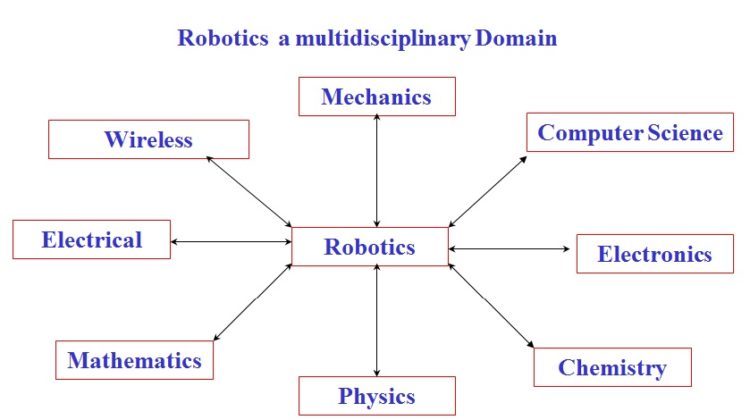!! Robotics, The ultimate road ahead of human species!!
Robotics has been fascinating the mind-set of human species since the last century. It has
redefined the way humans have been advancing their lives. The word “robota” meaning work
was coined by Czech playwright and author Karl Capek in 1921. Seemingly, today robotics is
defining every aspect of human life and how humans are shaping the future of the world and
the universe at large.
First generation robotics was all about automation of mechanical structure performing
ordinary functions meant for humans. With the advent of electricity and electronics,
programmable manipulators referred to as industrial robots performing dull, difficult, dirty
and dangerous tasks laid the foundation for industrial revolution and manufacturing
industries. This era is referred as second generation robotics. The third generation of robotics
began with the development of computing platforms like microprocessors, microcontrollers
and reconfigurable computing devices. The fast computing devices resulted in the growth of
domestic robotics and completely automated the functioning industries by performing
adventurous, augmentative, and adaptive tasks not feasible for humans.
The fourth generation robotics based on artificial intelligence, machine learning and selflearning
systems coupled with rapid advancement in miniaturization of devices, sensors,
driver systems, and actuators have resulted in lighter, smarter and intelligent systems. Space
travel, deep sea exploration, defence vehicles, drones, medical surgery, domestic life and
entertainment have been transformed by intelligent robotics systems.
The fifth generation of robotics combines reconfigurable mechanical structures like
transformers, biology-inspired systems and materials like cyborgs, intelligent integrative
humanoids, and material science to replicate not just functionality of living things like
humans but also extending the capabilities which were not possible decades ago. The real
reason behind the human progress is to be defined by convergence of information technology,
biotechnology, cognitive technology and material technology.
Recently, there has been a drastic change in Information Technology (IT) and IT Enabled
Service (ITES) Industry wherein self-learning systems and machine learning are slowly
replacing service professionals. These small steps are the reflections of how the future
industry would work. Combined with digital and automated manufacturing systems, Robotics
and Artificial Intelligence will reshape the coming decades similar to what has been done
with regard to wireless communication industry (mobile phones) and its implications on
society at large.
The recent breakthroughs in brain machine interfaces and the ease of transferring information
between a digital system and living brain in tandem with virtual reality in a two way
communication system provides capabilities for the human species to explore space and time
as never before.
Figure 1: Multidisciplinary aspect of Robotics
For an aspiring student who has genuine interest to design and built robots one can take
different paths to achieve the goal. First and foremost one must have solid foundation in basic
engineering like electronics, communication, mechanical and information technology. Based
on this basic knowledge one can start building one’s career. Since Robotics and artificial
intelligence are multidisciplinary fields, it’s better to specialize in one domain like
programming skills, embedded system development, basic discrete electronics, or wireless
communication systems or reconfigurable mechanical system. But the basic requirement is to
have good understanding of formal science that is mathematics and logic. Being a master of
one and jack of a couple of other fields allows an engineer to be not just a skilled labourer but
also knowledgeable and creative. In the transient scenario in the Information Technology,
Manufacturing, transportation systems and mobile computing industries, Machine learning
and mobile communication based hand held devices are totally transforming the working
environment. This requires additional understanding of Artificial intelligence (AI).
Please do follow up with the article on intelligent systems to understand more about AI.
For further information regarding how to establish an exciting career please visit us at
www.ppcrc.in
Author Name:
Prof. Rabinder Henry
Director
Pralhad P Chhabria Research Center, Pune
www.ppcrc.in
www.isquareit.edu.in
www.famt.ac.in
Prof. Rabinder. Henry is currently the Director at Pralhad P.Chhabria Research Center, Pune (A Project of Finolex). His
thrust areas of work have been in transforming the education system specifically in Engineering Higher Education by
making it more applied intelligence oriented. Formerly been Director for Engineering Colleges and also been CTO in the
industry. He has a Master of Science Degrees in RF & Microwave Engineering (1) and Photonics (2) from Technical
University Dresden and Master of Science in Medical Systems Engineering (3) form University of Magdeburg, Germany. He
has worked with Fraunhofer Institute for Photonics Microsystems, Institute for Mikrosystemtechnik, Magdbeurg and
Helmholtz Zentrum Rossendorf, Germany. His areas of interest include Microwave Engineering, Microfabrication, Bio
implants, Photonics, Nanotechnology and convergence of technology. Professional member of many bodies IEEE, VLSI
Society of India, ISTE, and ISC etc. Established Institutes at Meerut, Jaipur and Pune.
His profile has been published by Marquis Publications in Who’s Who in World 2009. Global Young Leader by UNDP
(United Nations Development Program) for Peace Initiative in 2008. Awarded by Society for Reliability Engineering,
Quality and Operations Management (SREQOM) for Innovative Applications of Information Technology in Interdisciplinary
areas in Science and Technology, December 2009.



Recent Comments